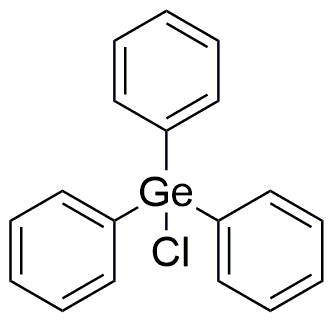Triphenylchlorogermane is widely utilized in research focused on:
- Organometallic Chemistry: This compound serves as a precursor for synthesizing various organometallic compounds, facilitating studies in catalysis and material science.
- Semiconductor Industry: It is used in the production of germanium-based semiconductors, which are critical for electronic devices, offering advantages in performance over silicon in certain applications.
- Pharmaceutical Research: The compound plays a role in developing new pharmaceuticals, particularly in drug delivery systems, enhancing the bioavailability of active ingredients.
- Surface Chemistry: It is employed in modifying surfaces of materials to improve their chemical properties, which is valuable in coatings and adhesives.
- Analytical Chemistry: Triphenylchlorogermane is utilized in various analytical techniques, aiding in the detection and quantification of trace elements in samples.
General Information
Properties
Safety and Regulations
Applications
Triphenylchlorogermane is widely utilized in research focused on:
- Organometallic Chemistry: This compound serves as a precursor for synthesizing various organometallic compounds, facilitating studies in catalysis and material science.
- Semiconductor Industry: It is used in the production of germanium-based semiconductors, which are critical for electronic devices, offering advantages in performance over silicon in certain applications.
- Pharmaceutical Research: The compound plays a role in developing new pharmaceuticals, particularly in drug delivery systems, enhancing the bioavailability of active ingredients.
- Surface Chemistry: It is employed in modifying surfaces of materials to improve their chemical properties, which is valuable in coatings and adhesives.
- Analytical Chemistry: Triphenylchlorogermane is utilized in various analytical techniques, aiding in the detection and quantification of trace elements in samples.
Documents
Safety Data Sheets (SDS)
The SDS provides comprehensive safety information on handling, storage, and disposal of the product.
Product Specification (PS)
The PS provides a comprehensive breakdown of the product’s properties, including chemical composition, physical state, purity, and storage requirements. It also details acceptable quality ranges and the product's intended applications.
Certificates of Analysis (COA)
Search for Certificates of Analysis (COA) by entering the products Lot Number. Lot and Batch Numbers can be found on a product’s label following the words ‘Lot’ or ‘Batch’.
*Catalog Number
*Lot Number
Certificates Of Origin (COO)
This COO confirms the country where the product was manufactured, and also details the materials and components used in it and whether it is derived from natural, synthetic, or other specific sources. This certificate may be required for customs, trade, and regulatory compliance.
*Catalog Number
*Lot Number
Safety Data Sheets (SDS)
The SDS provides comprehensive safety information on handling, storage, and disposal of the product.
DownloadProduct Specification (PS)
The PS provides a comprehensive breakdown of the product’s properties, including chemical composition, physical state, purity, and storage requirements. It also details acceptable quality ranges and the product's intended applications.
DownloadCertificates of Analysis (COA)
Search for Certificates of Analysis (COA) by entering the products Lot Number. Lot and Batch Numbers can be found on a product’s label following the words ‘Lot’ or ‘Batch’.
*Catalog Number
*Lot Number
Certificates Of Origin (COO)
This COO confirms the country where the product was manufactured, and also details the materials and components used in it and whether it is derived from natural, synthetic, or other specific sources. This certificate may be required for customs, trade, and regulatory compliance.


